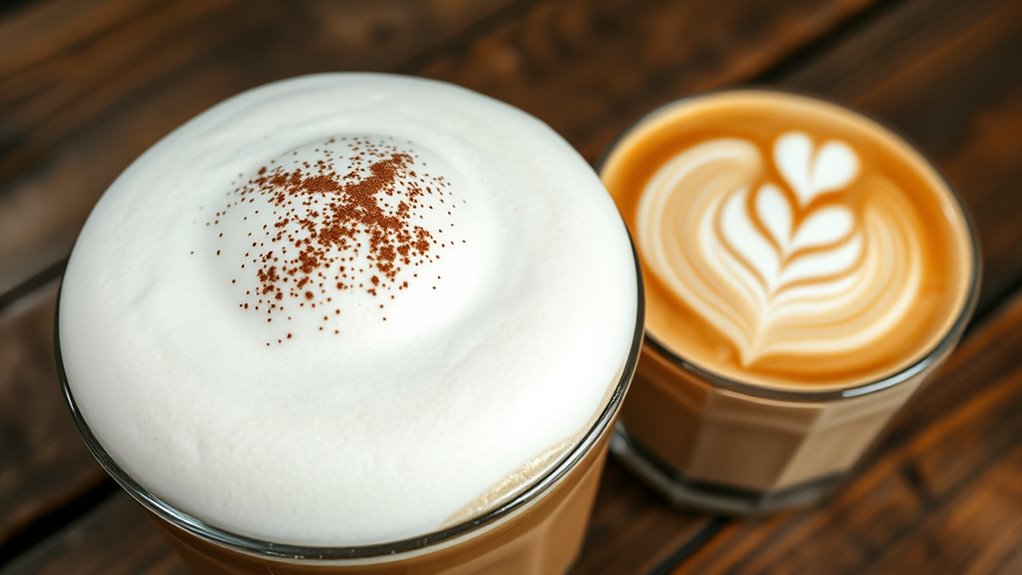Adding milk to coffee dates back centuries, originating in the Middle East and spreading through Europe. The cappuccino and latte evolved as variations, each blending espresso and steamed milk to create rich, creamy drinks. Over time, baristas developed techniques like foam art, elevating these beverages into visual masterpieces. If you want to explore how these iconic drinks became artful expressions of coffee craftsmanship, there’s plenty more to discover.
Key Takeaways
- The practice of adding milk to coffee dates back to 17th-century Europe, enhancing flavor and reducing acidity.
- Cappuccino and latte evolved from traditional Italian coffee drinks, each developing distinct milk preparation techniques over centuries.
- The term “cappuccino” originated from the resemblance of the drink’s foam to Capuchin friars’ robes in the 1700s.
- Milk steaming and frothing techniques improved significantly during the 19th and 20th centuries with advances in espresso machine technology.
- Milk art and presentation styles became popular in the 20th century, elevating the cultural and visual appeal of milk-based coffee drinks.

Have you ever wondered what sets a cappuccino apart from a latte? It all comes down to how the milk is prepared and the coffee brewing process. Both drinks start with a shot of espresso, but their textures and presentations differ markedly. When you order a cappuccino, you’re getting a balanced blend of rich, robust coffee topped with a thick layer of frothy milk. Conversely, a latte features more steamed milk, making it creamier and less intense in flavor. The art of creating these drinks lies in mastering milk texturing and pouring techniques—particularly milk art, which transforms a simple beverage into a visual masterpiece.
In coffee brewing, the quality of your espresso shot forms the foundation for a great cappuccino or latte. A well-pulled shot extracts the coffee’s oils and flavors, providing a strong base that complements the milk’s sweetness and creaminess. Once brewed, the milk’s treatment becomes vital. For a cappuccino, you want to steam the milk until it forms a velvety foam. This foam should be dense yet light, capable of holding intricate designs if you’re skilled enough. Milk art then becomes a showcase of your craftsmanship, as you pour the textured milk in a way that creates patterns like hearts, rosettas, or tulips. The key is controlling the pour’s speed and angle, allowing the foam to flow naturally into the espresso and form the design.
On the other hand, making a latte involves steaming milk to a silky, smooth consistency, with less emphasis on foam. The goal is to produce a creamy texture that blends seamlessly with the espresso, creating a mellow, inviting drink. While milk art is still possible on a latte, it tends to be simpler because the milk is more liquid than foam. The focus here is on the balance between coffee and milk, making it ideal for those who prefer a milder, less intense coffee experience. Whether you’re preparing a cappuccino or a latte, mastering the technique of milk pouring and understanding the nuances of coffee brewing are essential skills that elevate your coffee experience. Additionally, the quality of equipment used can significantly impact the final texture and flavor of your drinks, highlighting the importance of good tools in coffee craftsmanship. Developing these skills often involves understanding the science of milk steaming, which helps in achieving the perfect texture for each beverage.
Ultimately, these differences reflect centuries of tradition and evolving techniques in coffee preparation. By honing your skills in coffee brewing and milk art, you can craft beverages that are not only delicious but also visually stunning. Whether you prefer the boldness of a cappuccino or the smoothness of a latte, understanding the art behind each drink allows you to appreciate the rich history and craftsmanship that go into every cup.
Frequently Asked Questions
When Did Milk First Become a Common Addition to Coffee?
You’re curious about when milk first became a common addition to coffee. Historically, the history of coffee shows that milk pairing traditions began in the 17th century, especially in Ottoman and European cultures. As coffee spread globally, people started adding milk to soften its strong flavor. By the 19th century, the popularity of milk-based coffee drinks like cappuccino and latte grew, cementing milk’s role in coffee culture worldwide.
Are There Regional Differences in How Milk Is Added to Coffee?
Think of milk in coffee as a colorful tapestry woven with regional preferences and cultural variations. You’ll find that in Italy, a cappuccino’s foam rules the roost, while in Turkey, thick, sweetened milk often takes center stage. In Asia, vibrant flavors blend with milk, and in the U.S., baristas craft personalized drinks. Regional differences shape how milk enriches your coffee experience, making each sip a unique cultural story.
How Did the Name “Latte” Originate?
You might wonder how the name “latte” originated. It comes from the Latin word “lac,” meaning milk, reflecting its core ingredient. Over time, linguistic evolution transformed “caffè latte” into simply “latte,” popularized in Italy and then worldwide. This evolution highlights how language adapts, making “latte” a straightforward term for a milk-infused coffee drink, showcasing its rich linguistic history.
What Are the Health Impacts of Adding Milk to Coffee?
Adding milk to coffee can impact your health in several ways. If you’re lactose intolerant, it might cause digestive issues unless you choose lactose-free options. Milk provides calcium, which supports bone health, but too much added sugar or cream can increase calorie intake and contribute to weight gain. You should balance your coffee with milk, considering your lactose intolerance and calcium needs, to enjoy benefits without adverse effects.
Which Cultures Have Unique Traditional Coffee Drinks With Milk?
Imagine traversing a vibrant tapestry of flavors, where each culture paints its own unique coffee story. In Turkey, you sip thick, frothy menemen with milk or yogurt, showcasing rich cultural variations. In Vietnam, you taste sweet, condensed milk-laden cà phê sữa đá. Meanwhile, dairy alternatives like soy or almond milk in Scandinavian countries add modern twists. You discover that these traditions celebrate local ingredients, creating diverse, culturally infused coffee experiences.
Conclusion
As you sip your cappuccino or latte, remember they’re more than drinks—they’re a dance of tradition and innovation. The milk, like a gentle heartbeat, unites bold coffee with tender warmth, symbolizing connection and comfort. Each cup tells a story of cultural blending and timeless artistry. So, embrace the ritual, letting the smooth blend remind you that beneath every layer lies a shared history—inviting you to savor both the flavor and the journey.









